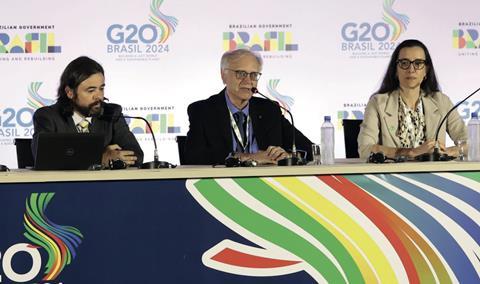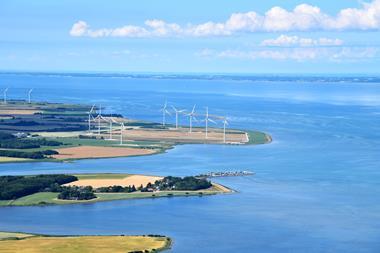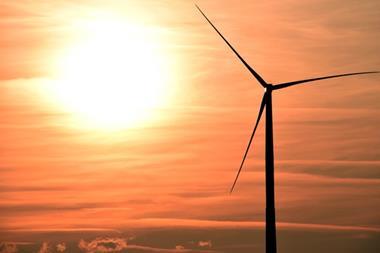Alexis Crow explores the opportunities for investing in private markets and ESG in Latin America’s largest economy
As investors ponder geographical asset allocation in the post-pandemic world – seeking long-term returns amid an uncertain global economic environment and a fragmented geopolitical landscape – Brazil’s star shines brightly. A better-than-expected recovery from the twinned health and economic shocks of COVID-19, successful central banking policy, several years of an elevated commodity price environment, and a slew of reforms with the potential to improve the ease of doing business and to boost sustainability within the country are contributing to a relatively stable macroeconomic outlook.
Added to that, while executives size up the repercussions of escalating geopolitical tensions between the US and China, and the impact on their portfolios around the world, Brazil’s neutral stance offers the potential for a balanced position in an increasingly fragmented landscape. At the start of 2024, Brazil’s assumption of the G20 presidency – and ascension into OPEC+ – reflect a renewed sense of vibrancy for Brazil’s standing in the global stage.

Paulo Picchetti (centre) of the Central Bank of Brazil at a G20 press conference in Sao Paulo. Brazil assumed presidency of the G20 this year
Looking to the sector-specific and business landscape, a series of reforms by the central bank, the regulator, and previous and current presidential administrations – as well as Brazil’s congress – places the country in pole position to garner foreign direct investment (FDI) flows across diversified sectors.
From the implementation of regulation supporting more foreign participation in Brazil’s financial services industry to the launch of the Brazil Central Bank’s (BCB) sustainability agenda – and from the introduction of mandated ESG reporting and reforms to the asset management space – as well as the passing of long-awaited tax reform, the cascade of continued policy reforms are contributing to a greater ease of doing business.
Strong fundamentals in the financial services sector (including wealth management and private markets) and in energy and infrastructure (including conventional forms of energy as well as renewables) merit a close look for executives with patient capital, as well as growing ESG mandates. At a time when the underlying business models (and performance metrics) of the private equity industry are ripe for revision in the US market, private markets are much earlier in the maturity curve in Brazil. As the industry develops in Latin America’s largest economy, some foreign investors may have a first-mover advantage, with the potential to partner with local entities, and also to use Brazil as a launchpad for exposure to the rest of the region.
Macroeconomic environment
In part, due to policy measures which had been implemented prior to the pandemic – as well as successful targeted fiscal policies and relief measures – Brazil’s economy weathered the COVID-19 storm in relatively strong standing. The landmark pension reform of 2019 resulted in a reduction of gross government debt, and even the temporary increase in spending related to COVID in 2020 was efficiently directed toward stimulating sectors of the economy which flourished during the pandemic economy years (Brazil’s manufacturing PMI hit an all-time high in October 2020, and formal job creation also hit a record high at that time).
“Amid a lofty commodity price environment in recent years, Brazil has enjoyed a trade surplus, as it exports significant amounts of liquid fuels and food stock across the globe”
Strong stewardship at the central bank (which has been officially politically independent since February 2021) has resulted in the continued implementation of macroprudential measures, placing the Brazilian economy on firm footing, even despite an uncertain external environment. Such measures include the maintenance of ample foreign exchange reserves, low foreign exchange debt and a flexible exchange rate regime.
With a focus on restoring price stability amid stickier inflation, the BCB forecasts a convergence toward its headline inflation target by mid-2025, and for Brazil’s Selic policy rate to be held correspondingly elevated through to 2025. GDP growth has hovered at 3% from 2022-23 and is forecast to moderate to about 1.7% in 2024. Amid a lofty commodity price environment in recent years, Brazil has enjoyed a trade surplus, as it exports significant amounts of liquid fuels and food stock across the globe.
On the financial front, Brazil enjoys a robust banking system and is “at the forefront of financial innovation”, according to the IFM, with its Pix digital instant payment system. A potential wholesale central bank digital currency is also in the works.
Most crucially, in late 2023, Brazil passed a long-awaited tax reform bill, which has actually resulted in a credit rating upgrade from one of the major rating agencies.
The reform simplifies a complex VAT taxation system and is likely to pave the way for successive reforms in income and corporate tax. This is likely a boon for foreign finance executives – tax preparation in Brazil has historically required between 1,500-2,000 hours per year, which ranks it as the most time-consuming filing process in the world.
The potential for a greater ease of doing business yielded by this tax reform is likely to prompt more foreign companies to invest in Brazil, and is likely to generate improved revenues, bolstering the country’s path to fiscal sustainability.
Brazil’s fiscal sustainability might also be bolstered by greater participation of foreign investors in the country’s sovereign debt market – and specifically, in green bonds. Late last year, Brazil launched its first ESG sovereign bond offering. An initial sale pegged at US$2bn (€1.87bn) was three times oversubscribed. Investors from North America and Europe held a preference for the environment or ‘E-related’ portions of the bonds, while 40-50% of the allocation was earmarked for the S, or social needs.
In the infrastructure space, Brazil has also announced a US$350bn investment plan – to be comprised of both private and public investments – to accelerate sustainability and energy transition. This growth acceleration plan covers both conventional as well as cleaner forms of energy, indicating that both can be incorporated in a path toward overall sustainability and economic growth.
Geopolitical landscape
If 2023 was the ‘year of the global south’, then Brazil stands in pole position to capture some of the trade winds directed towards emerging markets and developing economies. Taking the helm from India, Brazil has assumed leadership of the G20, and has just joined OPEC+. Additionally, the country will host COP30 in 2025 – again, evidencing the fact that a country can lead in both traditional as well as renewable energy production. Mirroring this, one of the largest foreign investors in Brazil has allocated capital to the production of hydrocarbons as well as renewables and – crucially – to R&D and human capital development.
Looking at the future of trade, Brazil has the potential to play a mightier role via Mercosur, which is Latin America’s largest trading bloc. As governments around the world are increasingly concerned with food security – and with garnering materials for the energy transition – Latin America’s outsized role in agriculture and lithium and copper supply chains is crucial to meeting global demand.
Accordingly, with an eye on the future of food supply and the provision of minerals, Japanese Prime Minister Kishida is in talks with Brazilian President Lula da Silva to explore an economic partnership agreement. This might take the shape of a ‘mega-FTA’ with Mercosur, which would place Japan in the footsteps of Singapore – the first Asian country to form an FTA with the LatAm bloc – and South Korea may soon follow suit.
Even looking beyond countries, individual companies are also investing ‘upstream’ in the minerals supply within Latin America; one electric vehicle producer has recently invested in a lithium mine in Brazil, evidencing the extent to which manufacturers are increasingly forming integrated supply chains in order to meet future patterns of demand.
Set against the backdrop of a fragmented global landscape, the discernible ideological shift to the left within many Latin American countries has raised concern amongst some foreign investors. Certainly, President Lula’s calls for ‘de-dollarisation’ (or an end to the predominance of the greenback in global trade), and the potential launch of a BRICs currency, have raised alarm bells for some US observers. Brazil’s recent deal with China to settle trade directly – in reals and renminbi, thus circumventing the US dollar – underscores the extent to which some of the south-south cooperation challenges the Washington consensus.
And yet, this position does not necessarily create risks for investors from the ‘global north’. Arguably, Brazil – as with other energy-exporting countries – has adopted a stance of ‘neutrality’ amid the geopolitical tensions between the US and China. But in launching its first sovereign green bond, foreign demand for the notes has been overwhelmingly come from North American and European investors. Similarly, as Brazil launches its $350bn investment plan in sustainability, the country continues to magnetise the largest infrastructure investors from global north. This evidences the extent to which a neutral stance does not necessarily mean ‘unaligned’.
Moreover, Brazil’s current stance of balancing investments in hydrocarbons and renewable forms of energy shows that it is possible to be neutral not only on the geopolitical stage but also on the geological stage. By maintaining this position, Brazil garnered 41% of foreign direct investment (FDI) flows to Latin America in 2022, with the country’s largest foreign investor deploying capital to traditional as well as green forms of energy and R&D and technology.
Brazil generates 80% of its electricity from renewable sources (a frontrunner in hydropower, the country has witnessed an exponential growth in solar capacity in recent years). It is the ninth-largest producer of crude oil in the world. In part due to its offshore reserves, it is forecast to become the sixth-largest oil exporter by 2030. Thus, the ability to hold new and older forms of energy means that Brazil can contribute to solutions on the global stage, as countries and companies navigate the realities of the energy transition and climate change.
At the sector level
As indicated, Brazil’s private markets are much earlier in the maturity curve in contrast with major markets in Europe, North America and Asia. On the demand side, part of the reason for this growth is that Brazilian households have steadily increased allocations to private investment. As the Selic rate descended between 2016 and 2021, yields on fixed income were not entirely promising. Brazilians put a record R$5.5trn in private investments in the first nine months of 2023, a record volume, and a 9.7% growth from the previous year. Property funds have been especially appealing to domestic retail investors.

Brazil has witnessed an exponential growth in solar capacity in recent years
For foreign investors, Brazilian private equity, venture capital, real estate and infrastructure markets offer exposure to a dynamic emerging market economy, when many groups are looking to diversify their geographical exposure (indeed, in light of mounting geopolitical concerns, many investors have quietly acknowledged their hunt for ‘EM ex-China’). The returns and value appreciation are certainly present – Brazil’s private investment funds raised between 1994 and 2022 returned an average 2.2x of invested capital and generated a 12.7% mean internal rate of return.
As a point of access, some of the world’s largest funds have teamed up with local groups to deepen exposure to Brazil’s private markets. One of the world’s largest multilateral development banks has teamed up with one leading infrastructure investor, and a Brazilian private equity company, in launching a climate-change investment fund. Another US private equity company has directly invested within a Brazilian private equity group, ostensibly to gain exposure to the local market, as well as across Latin America.
This flurry of activity in both private markets – as well as sustainability – is also supported by ongoing reforms by the regulator. Brazil’s securities and exchange commission, CVM, introduced Resolution 175, initiating a new regulatory framework for the country’s asset management industry. Additionally, the CVM’s issuance of the landmark Resolution 193 introduces sustainability disclosure requirements for publicly traded companies, investment funds and securitisation, in keeping with standards set by the International Sustainability Standards Board.
As the reporting mandates come into effect, Brazil might in turn court more foreign participation in its financial markets, as investors seeking to tick the ESG box – as well as geographical diversification – might flock to both the private and public investment spaces.

Certainly, in looking out to an uncertain external environment, the Brazilian economy is not without its challenges. In purchasing power parity, Brazil lags behind regional peers Mexico and Argentina. And despite an emphasis on the ‘bolsa familia’ in this current and previous administration, mandatory spending on pensions and wages has often benefited higher-income households. But it is with the hope that as Brazil magnetises more foreign participation in its sovereign, capital and private markets – commensurate with the implementation of ongoing reforms – that spending is channelled into productive investments that yield long-term returns for capital providers, as well as for the society as a whole.
Brazil’s assumption of leadership on the entire energy spectrum – and corollary magnetisation of FDI in renewables as well as conventional energy – evidences the extent to which such investments can contribute to human capital development and improved livelihoods, thus creating a positive feedback loop for truly sustainable growth in Latin America’s largest economy.


















